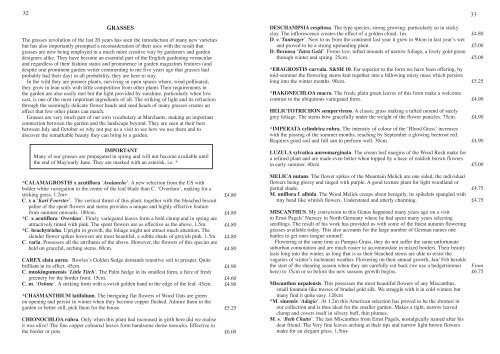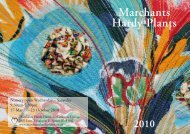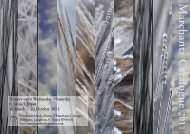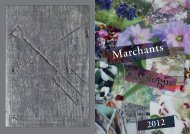download our catalogue free in pdf format here - Marchants Hardy ...
download our catalogue free in pdf format here - Marchants Hardy ...
download our catalogue free in pdf format here - Marchants Hardy ...
You also want an ePaper? Increase the reach of your titles
YUMPU automatically turns print PDFs into web optimized ePapers that Google loves.
32<br />
33<br />
GRASSES<br />
The grasses revolution of the last 20 years has seen the <strong>in</strong>troduction of many new varieties<br />
but has also importantly prompted a reconsideration of their uses with the result that<br />
grasses are now be<strong>in</strong>g employed <strong>in</strong> a much more creative way by gardeners and garden<br />
designers alike. They have become an essential part of the English garden<strong>in</strong>g vernacular<br />
and regardless of their fashion status and prom<strong>in</strong>ence <strong>in</strong> garden magaz<strong>in</strong>es features (and<br />
despite one prom<strong>in</strong>ent garden writer comment<strong>in</strong>g to me five years ago that grasses had<br />
probably had their day) <strong>in</strong> all probability, they are <strong>here</strong> to stay.<br />
In the wild they are pioneer plants, surviv<strong>in</strong>g <strong>in</strong> open spaces w<strong>here</strong>, w<strong>in</strong>d poll<strong>in</strong>ated,<br />
they grow <strong>in</strong> lean soils with little competition from other plants Their requirements <strong>in</strong><br />
the garden are also easily met but the light provided by sunsh<strong>in</strong>e, particularly when low<br />
cast, is one of the most important <strong>in</strong>gredients of all. The strik<strong>in</strong>g of light and its refraction<br />
through the seem<strong>in</strong>gly delicate flower heads and seed heads of many grasses creates an<br />
effect that few other plants can match.<br />
Grasses are very much part of <strong>our</strong> own vocabulary at <strong>Marchants</strong>, mak<strong>in</strong>g an important<br />
connection between the garden and the landscape beyond. They are seen at their best<br />
between July and October so why not pay us a visit to see how we use them and to<br />
discover the remarkable beauty they can br<strong>in</strong>g to a garden.<br />
DESCHAMPSIA cespitosa. The type species, strong grow<strong>in</strong>g, particularly so <strong>in</strong> sticky<br />
clay. The <strong>in</strong>florescence creates the effect of a golden cloud. 1m.<br />
D. c.‘Tautrager’. New to us from the cont<strong>in</strong>ent last year it grew to 90cm <strong>in</strong> last year’s wet<br />
and proved to be a strong upstand<strong>in</strong>g plant.<br />
D. flexuosa ‘Tatra Gold’. Forms low, tufted mounds of narrow foliage, a lively gold-green<br />
through w<strong>in</strong>ter and spr<strong>in</strong>g. 25cm.<br />
*ERAGROSTIS curvula. S&SH 10. Far superior to the form we have been offer<strong>in</strong>g, by<br />
mid-summer the flower<strong>in</strong>g stems knit together <strong>in</strong>to a billow<strong>in</strong>g misty mass which persists<br />
long <strong>in</strong>to the w<strong>in</strong>ter months. 90cm.<br />
*HAKONECHLOA macra. The fresh, pla<strong>in</strong> green leaves of this form make a welcome<br />
contrast to the ubiquitous variegated form.<br />
HELICTOTRICHON sempervirens. A classic grass mak<strong>in</strong>g a tufted mound of steely<br />
grey foliage. The stems bow gracefully under the weight of the flower panicles. 75cm.<br />
*IMPERATA cyl<strong>in</strong>drica rubra. The <strong>in</strong>tensity of col<strong>our</strong> of the ‘Blood Grass’ <strong>in</strong>creases<br />
with the pass<strong>in</strong>g of the summer months, reach<strong>in</strong>g by September a glow<strong>in</strong>g beetroot red.<br />
Requires good soil and full sun to perform well. 30cm.<br />
£4.80<br />
£5.00<br />
£5.00<br />
£5.25<br />
£4.90<br />
£4.90<br />
£4.90<br />
IMPORTANT<br />
Many of <strong>our</strong> grasses are propagated <strong>in</strong> spr<strong>in</strong>g and will not become available until<br />
the end of May/early June. They are marked with an asterisk, i.e. *<br />
LUZULA sylvatica aureomarg<strong>in</strong>ata. The cream leaf marg<strong>in</strong>s of the Wood Rush make for<br />
a ref<strong>in</strong>ed plant and are made even better when topped by a haze of reddish brown flowers<br />
<strong>in</strong> early summer. 40cm<br />
£5.00<br />
*CALAMAGROSTIS x acutiflora ‘Avalanche’. A new selection from the US with<br />
bolder white variegation to the centre of the leaf blade than C. ‘Overdam’, mak<strong>in</strong>g for a<br />
strik<strong>in</strong>g grass. 1.2m+.<br />
C. x a.‘Karl Foerster’. The vertical thrust of this plant, together with the bleached biscuit<br />
pallor of the spent flowers and stems provides a unique and highly effective feature<br />
from summer onwards. 180cm.<br />
*C. x acutiflora ‘Overdam’. F<strong>in</strong>ely variegated leaves form a bold clump and <strong>in</strong> spr<strong>in</strong>g are<br />
attractively t<strong>in</strong>ted with p<strong>in</strong>k. The spent flowers are as effective as the above. 1.5m.<br />
*C. brachytricha. Upright <strong>in</strong> growth, the foliage might not attract much attention. The<br />
slender flower spikes however are most beautiful, a subtle shade of greyish p<strong>in</strong>k. 1.5m.<br />
C. varia. Possesses all the attributes of the above. However, the flowers of this species are<br />
held on graceful, arch<strong>in</strong>g stems. 60cm.<br />
CAREX elata aurea . Bowles’s Golden Sedge demands retentive soil to prosper. Quite<br />
brilliant <strong>in</strong> its effect. 45cm.<br />
C. musk<strong>in</strong>gumensis ‘Little Titch’. The Palm Sedge <strong>in</strong> its smallest form, a fuzz of fresh<br />
greenery for the border front. 15cm.<br />
C. m. ‘Oehme’. A strik<strong>in</strong>g form with a swish golden band to the edge of the leaf. 45cm.<br />
*CHASMANTHIUM latifolium. The <strong>in</strong>trigu<strong>in</strong>g flat flowers of Wood Oats are green<br />
on open<strong>in</strong>g and persist <strong>in</strong> w<strong>in</strong>ter when they become copper flushed. Admire them <strong>in</strong> the<br />
garden or better still, pick them for the house.<br />
CHIONOCHLOA rubra. Only when this plant had <strong>in</strong>creased <strong>in</strong> girth <strong>here</strong> did we realise<br />
it was alive! The f<strong>in</strong>e copper col<strong>our</strong>ed leaves form handsome dense tussocks. Effective <strong>in</strong><br />
the border or pots.<br />
£4.80<br />
£4.80<br />
£4.80<br />
£4.80<br />
£4.80<br />
£4.90<br />
£4.60<br />
£4.90<br />
£5.25<br />
£6.00<br />
MELICA nutans. The flower spikes of the Mounta<strong>in</strong> Melick are one sided, the <strong>in</strong>dividual<br />
flowers be<strong>in</strong>g glossy and t<strong>in</strong>ged with purple. A good texture plant for light woodland or<br />
partial shade.<br />
M. uniflora f. albida. The Wood Melick creeps about benignly, its spikelets spangled with<br />
t<strong>in</strong>y bead like whitish flowers. Understated and utterly charm<strong>in</strong>g.<br />
MISCANTHUS. My conversion to this Genus happened many years ago on a visit<br />
to Ernst Pagels’ Nursery <strong>in</strong> North Germany w<strong>here</strong> he had spent many years select<strong>in</strong>g<br />
seedl<strong>in</strong>gs. The result of his work has provided us with some of the f<strong>in</strong>est autumn flower<strong>in</strong>g<br />
grasses available today. This also accounts for the large number of German names one<br />
battles to get ones tongue around!<br />
Flower<strong>in</strong>g at the same time as Pampas Grass, they do not suffer the same unfortunate<br />
suburban connotation and are much easier to accommodate <strong>in</strong> mixed borders. Their beauty<br />
lasts long <strong>in</strong>to the w<strong>in</strong>ter, as long that is as their bleached stems are able to resist the<br />
vagaries of w<strong>in</strong>ter’s <strong>in</strong>clement weather. Flower<strong>in</strong>g on their annual growth, Jan/ Feb heralds<br />
the start of the shear<strong>in</strong>g season when they are carefully cut back (we use a hedgetrimmer<br />
<strong>here</strong>) to 15cm or so before the new seasons growth beg<strong>in</strong>s.<br />
Miscanthus nepalensis. This possesses the most beautiful flowers of any Miscanthus,<br />
small founta<strong>in</strong>-like tresses of braded gold silk. We struggle with it <strong>in</strong> cold w<strong>in</strong>ters but<br />
many f<strong>in</strong>d it quite easy. 120cm<br />
*M. s<strong>in</strong>ensis ‘Adagio’. At 1.2m this American selection has proved to be the shortest <strong>in</strong><br />
<strong>our</strong> collection and is thus ideal for the smaller garden. Makes a tight, narrow leaved<br />
clump and covers itself <strong>in</strong> silvery buff, th<strong>in</strong> plumes.<br />
M. s. ‘Beth Chatto’. The last Miscanthus from Ernst Pagels, nostalgically named after his<br />
dear friend. The Very f<strong>in</strong>e leaves arch<strong>in</strong>g at their tips and narrow light brown flowers<br />
make for an elegant grass. 1.5m+<br />
£4.75<br />
£4.75<br />
From<br />
£6.75





